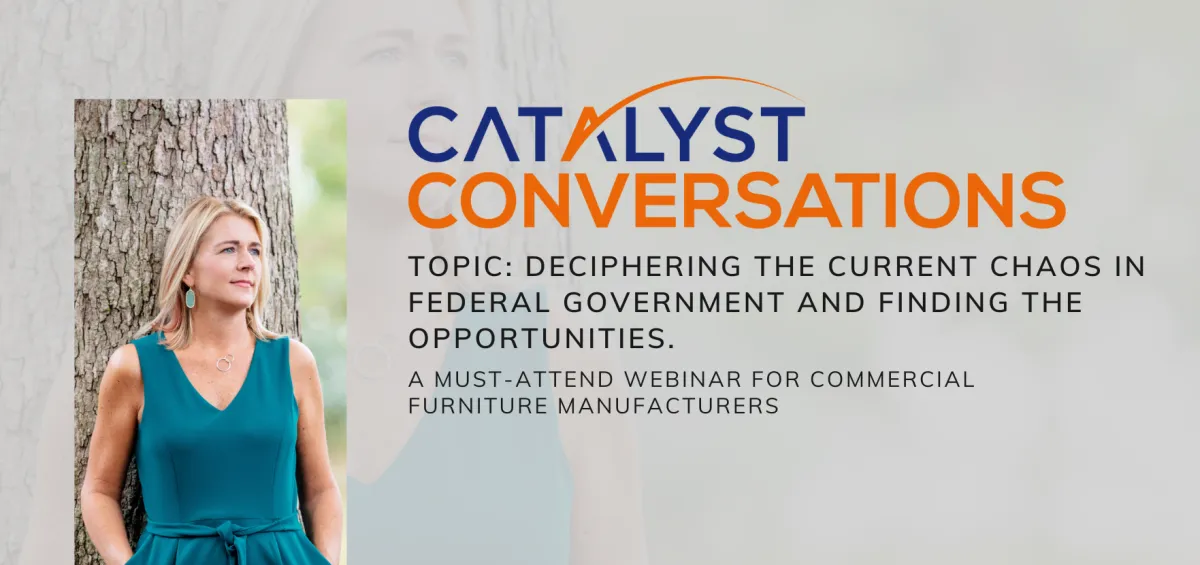
Deciphering the Chaos in Federal Government

Key Takeaways for the Furniture Industry
The April Catalyst Conversation, titled “Deciphering the Current Chaos in Federal Government and Finding the Opportunities,” was an insightful and timely discussion featuring industry experts from Catalyst Consulting Group, The Gormley Group, and PB Infusion. With so much change and uncertainty across the federal landscape, the session provided much-needed clarity and guidance—particularly for those navigating the furniture industry’s role in public sector procurement.
Here are the major takeaways from the conversation:
1. Federal Contract Changes: What You Need to Know
Chris Arndt, a seasoned expert in GSA contracts, unpacked several shifts affecting contractors:
Tariffs & Price Adjustments: Rising tariffs have led to increased costs, but relief is possible. The most effective strategy? Increase your commercial pricelist and submit that to GSA. Thanks to recent memos, previous caps on price increases (like the 10% rule) are no longer in place.
DEI Clauses Eliminated: Diversity, Equity, and Inclusion (DEI) mandates have been rolled back. Maintaining DEI language in your federal contracts could now result in violations of the False Claims Act. Businesses are urged to be cautious about language and programs related to DEI in federal dealings.
Cybersecurity (CMMC) Compliance: Cybersecurity Maturity Model Certification (CMMC) is now a real concern, especially for firms dealing with building plans from agencies like the DoD. Level 2 certification—often required for controlled unclassified information (CUI)—requires costly third-party verification. Some companies have already faced this in recent RFP amendments.
Socioeconomic Program Reductions: Many longstanding mandates like affirmative action and EEOC compliance are being scaled back. Only requirements related to veterans and persons with disabilities remain mandated by statute.
GSA’s Changing Landscape: GSA is streamlining. The Public Buildings Service (PBS) is being downsized, but the Federal Acquisition Service is expanding. Be aware: low sales volume and poor compliance reports are leading to contract cancellations.
2. Opportunities Are Still Abundant
Despite the turbulence, Catalyst’s Federal specialist Ryan H. reported a 13% increase in GSA furniture spending year-over-year in Q1 and Q2. This uptick signals a strong pipeline, particularly in sectors like defense and healthcare.
Kerry Ferguson emphasized a “new era” of government procurement and stressed the importance of:
Monitoring agency forecasts and budgets
Identifying contracting trends (e.g., leasing upticks, decentralization)
Engaging early with agencies and attending industry days
Ryan added that workforce shifts and hiring booms—especially in agencies like the VA and DHS—translate directly into increased demand for office furniture and workplace infrastructure.
3. Vacuums Create Opportunity
As Ryan pointed out, “Anytime we’re faced with recession or regulation change, vacuums emerge—and those are opportunities.” With many contracting officers retiring or being reassigned, new hires are likely. Every new hire means a new workstation, chair, and equipment. That’s furniture business.
This extends to cybersecurity too. Dealers who invest in CMMC certifications now can offer turnkey solutions to manufacturers unable to handle classified information—positioning themselves as critical supply chain partners.
4. Strategic Agency Focus
Chris Arndt and Kerry Ferguson highlighted a few key agencies to watch:
DoD/Navy: High demand and funding increases expected.
VA: Patient care needs aren’t declining, meaning furniture and equipment procurement will remain steady.
DHS: Poised for growth.
Education: Not currently a strategic focus due to this department being eliminated.
Kerry also emphasized the need for manufacturers and reps to stay plugged in at the agency level, particularly through forecasts and pre-solicitation briefings.
5. Stay Sharp, Stay Informed
The federal procurement landscape is evolving quickly. Everyone on the panel recommended subscribing to updates from legal firms like Holland & Knight or Sheppard Mullin. Even if some updates are dry, staying informed is essential.
Michelle Warren closed by reiterating that “chaos breeds opportunity”—and with the federal government still the world’s largest buyer, the furniture industry is well-positioned to adapt and grow.
Up Next
We are excited about two upcoming opportunities to deepen your public sector strategy:
Catalyst Conversations – July 10 th – Topic: Maximizing Your Year-End Push
As many public agencies approach their fiscal year-end, this session will focus on how to
position your business to take advantage of remaining budgets and strategic opportunities. We will explore how to finish the year strong using cooperative contracts, targeted outreach, and
public sector timing.
Public Sector Decoded – July 17th
This virtual event is designed to demystify how government purchasing works. Whether you are just getting started or refining your approach, this session will break down key terms, purchasing cycles, and proven tactics to help you sell smarter in the public sector.
Conclusion
The current shakeups in federal procurement might look like obstacles—but they are, in fact, windows of opportunity. By understanding compliance requirements, tapping into emerging agency needs, and maintaining adaptability, businesses in the furniture space can not only weather the changes but thrive because of them.
